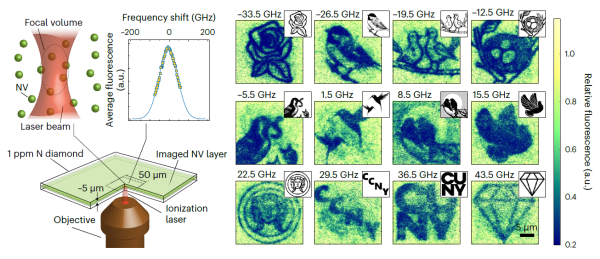A technology discovered by physicists at The City College of New York has the potential to improve optical data storage capacity in diamonds. This is made feasible by multiplexing spectral storage. The study, conducted by Richard G. Monge and Tom Delord of CCNY’s Division of Science’s Meriles Group, is titled “Reversible optical data storage below the diffraction limit” and published in the journal Nature Nanotechnology.

Protocol for charge state control of color centers in a high-density sample. CCNY researchers address sub-ensembles of atoms at the same spot but at different frequencies to imprint 12 images at the same location. Image Credit: Nature Nanotechnology
It means that we can store many different images at the same place in the diamond by using a laser of a slightly different color to store different information into different atoms in the same microscopic spots. If this method can be applied to other materials or at room temperature, it could find its way to computing applications requiring high-capacity storage.
Tom Delord, Postdoctoral Research Associate, The City College of New York
The small component known as “color centers” found in diamonds and related materials was the subject of the CCNY study. In essence, they are light-absorbing atomic defects that provide a foundation for quantum technologies.
Delord added, “What we did was control the electrical charge of these color centers very precisely using a narrow-band laser and cryogenic conditions. This new approach allowed us to essentially write and read tiny bits of data at a much finer level than previously possible, down to a single atom.”
The “diffraction limit,” or the smallest diameter a beam may be concentrated to, roughly scales as half the wavelength of the light beam. This limit determines the resolution of optical memory technologies (for example, green light would have a diffraction limit of 270 nm).
“So, you cannot use a beam like this to write with resolution smaller than the diffraction limit because if you displace the beam less than that, you would impact what you already wrote. So normally, optical memories increase storage capacity by making the wavelength shorter (shifting to the blue), which is why we have “Blu-ray” technology,” Delord further added.
The diffraction limit is avoided by the CCNY optical storage method, which sets itself apart from previous approaches by making use of the minute color (wavelength) variations that exist between color centers that are separated by less than the diffraction limit.
By tuning the beam to slightly shifted wavelengths, it can be kept at the same physical location but interact with different color centers to selectively change their charges-that is to write data with sub-diffraction resolution.
Richard G. Monge, Postdoctoral Fellow, The City College of New York
The reversible nature of this strategy is another distinctive feature.
Monge concluded, “One can write, erase, and rewrite an infinite number of times. While there are some other optical storage technologies also able to do this, this is not the typical case, especially when it comes to high spatial resolution. A Blu-ray disc is again a good reference example -- you can write a movie in it but you cannot erase it and write another one.”
Journal Reference
Monge, R, et. al. (2023) Reversible optical data storage below the diffraction limit. Nature Nanotechnology. doi:10.1038/s41565-023-01542-9.